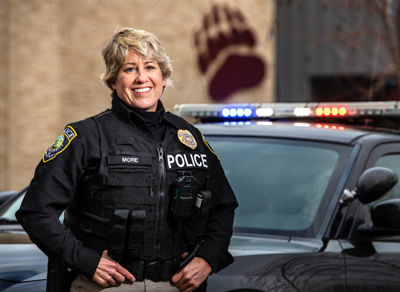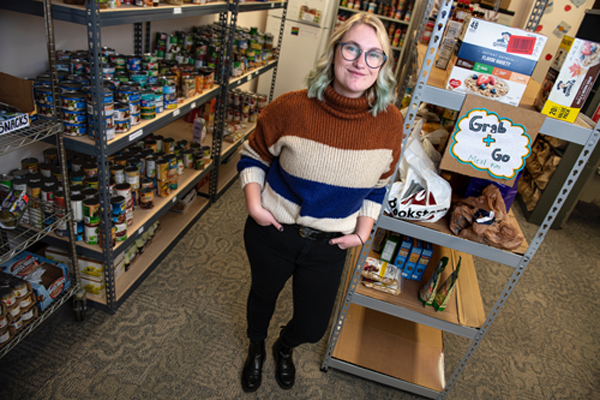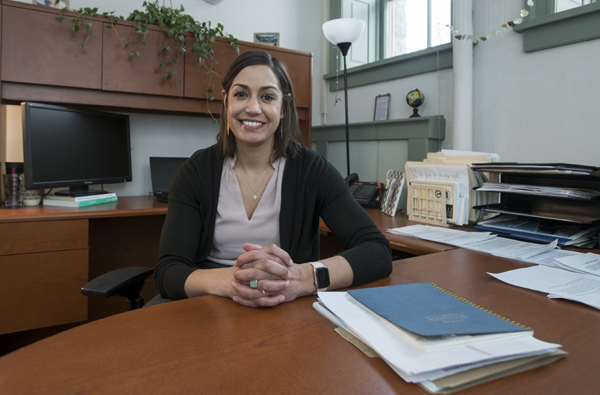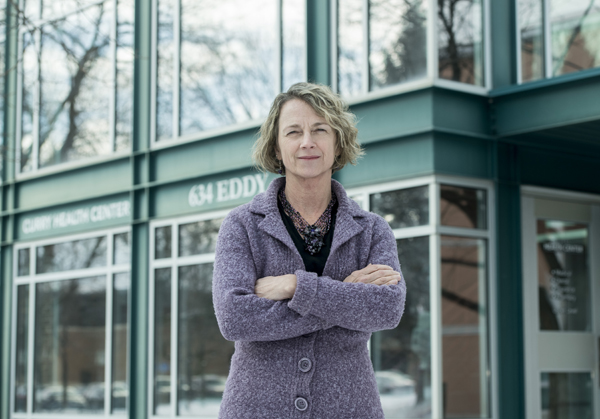- Editorial Offices
- 203 Brantly Hall
- Missoula, MT 59812
- (406) 243-2488
- themontanan@umontana.edu
SAFE
S.E.A. begins with 'S' because safety rests at the heart of the University of Montana's mission to provide access to a quality education.At UM, a safe environment for learning and working is not a static state, but rather an ongoing, deliberate effort.
We take seriously our responsibility to foster a safe community, which includes rigorous attention to factors that threaten safety. From ensuring a well-lit campus to offering free rides home to maintaining a campus police presence, we prioritize physical security. But we also define safety broadly. The UM Food Pantry addresses food security, various committees and groups nurture a more inclusive campus, and our Student Advocacy Resource Center provides direct services in support of all students. Campus trainings on implicit bias and other forms of discrimination combat the systemic drivers of unsafe environments, and policies allow for flexible work schedules and child care to honor our students’ and employees’ varied realities.
Central to our ongoing efforts to provide a safe environment is addressing sexual misconduct and choosing to be a leader in creating a safe and nurturing campus for all. No college campus is immune to the harsh realities of sexual assault, and UM has faced the issue both publicly and with an uncompromising commitment to best practices. Every day, women across the country experience exploitation of their sense of safety, which we address through a robust suite of programs for all students. Our coordinated effort among campus experts, University police, city and county law enforcement, the Student Advocacy Resource Center and others has been recognized as a national model.
These women working on the UM campus contribute to safety in their own ways:
 On the occasional morning, Shelagh More stands near the waffle iron in UM’s Food Zoo, striking up light conversation with students while they wait for breakfast.
On the occasional morning, Shelagh More stands near the waffle iron in UM’s Food Zoo, striking up light conversation with students while they wait for breakfast.
As the Special Victims Unit detective in the UM Police Department, she and other officers like to be visible to the students on campus wherever and whenever they can, including the Food Zoo, as part of UM’s commitment to safety.
“We’re not coming in to do enforcement, write tickets, make arrests,” she says. “We’re just here to eat some food. Most students, when they see you’re not in enforcement capacity, they relax.”
More contributes to a safe campus through her work following up on felony crimes whenever they take place at UM or involve a student, in conjunction with the Missoula Police Department Special Victims Unit. This close coordination between UMPD and the city’s police department is a notable community strength benefiting all students.
“The University setting, although it is encapsulated within the city of Missoula, is a unique environment in which to be a law enforcement officer,” More says.
She investigates assault, drug crimes, criminal mischief, domestic violence, rape, car accidents, thefts, stalking and more. Just as complex as the calls coming in to the city police department, some cases involve young adults just out of high school who may not know how the criminal justice system works.
A component of More’s job is informing students and speaking with resident assistants about the misinformation on police work during her walk-through of residence halls at night. She also speaks at Orientation and helps send our public service announcements to campus.
She says many students think the time frame for investigating felony crimes is similar to the popular TV show “CSI,” where results for evidence are received in seconds and someone’s location can by pinpointed right away. More says working a case in real life is a lot like writing a research paper. The process involves interviewing victims, suspects and witnesses, and report-writing, as well as examining evidence, which typically takes months.
“Criminal investigation takes time, it takes digging, it takes legwork,” More says. Doing this work with an eye toward rigor helps promote a safer campus environment.
***
Kat Cowley deals with another kind of safety crucial to those on and off campus – food security. Cowley is a Master of Public Administration graduate student and the student coordinator for the UM Food Pantry, which opened this past February.
She defines food insecurity as anything from only being able to afford to eat at Taco Bell every day to eating ramen for weeks on end.
 “Anyone can end up in situations where they are food insecure,” she says. “It can look like a lot of different things.”
“Anyone can end up in situations where they are food insecure,” she says. “It can look like a lot of different things.”
Her own story regarding food insecurity is personal. Cowley experienced it as an undergraduate sophomore working a minimum wage job and again as a senior, when she left an unsafe relationship and lost her housing. Cowley says it was very frustrating that there were no options for food assistance at UM, where she spent all her time and energy.
“I know firsthand how genuinely scary it is to not know where your next meal is coming from,” Cowley says. “I hope that by providing food to students for free, I can alleviate some of that fear.”
Cowley cites low wages and high housing prices in Missoula as factors contributing to food insecurity for students. Many students also have limited hours available to work because they are going to school. And sometimes those leaving unstable relationships may need food pantry resources as well.
“In cases of domestic violence, often one of the reasons a victim/survivor can't leave is because of a significant financial burden,” Cowley says. “By providing food either at the main pantry location or to SARC's client food pantry, we hope to relieve some of that burden.”
November saw the most visits to the Food Pantry since its opening. Overall the pantry has served a total of 179 individual students in 403 visits.
“There’s no qualifications to use the pantry itself,” Cowley says. “We just want to get people food.”
***
As UM’s Title IX coordinator and director of equal opportunity, Alicia Arant contributes to a safe campus as an enforcer of a bundle of state and federal civil rights laws, including Title VII of the Civil Rights Act, Title IX of the Education Amendments of 1972 and the Montana Human Rights Act.
 Those laws form the basis of UM’s Discrimination, Harassment, Sexual Misconduct, Stalking, and Retaliation Policy, which applies to everyone, from students and employees to affiliates and visitors.
Those laws form the basis of UM’s Discrimination, Harassment, Sexual Misconduct, Stalking, and Retaliation Policy, which applies to everyone, from students and employees to affiliates and visitors.
Arant addresses sex discrimination and holds perpetrators of sexual crimes accountable through a formal investigation process or an informal resolution involving training, mediation and accommodations. A Title IX investigation only results in University action, not legal consequences.
Arant says she ultimately works to ensure the dignity of people on campus.
“I have learned that a person’s sense of safety is inextricably tied to their sense of dignity, and no employee can bring their best self to work when their sense of dignity is challenged by discrimination or harassment,” she says.
Arant says that sex discrimination can include everything from disparate treatment to pay inequality to sexual assault to implicit bias.
“To me, regardless of context, a person who feels safe feels empowered to say ‘no’ – whether in a bedroom or a boardroom – because she will be heard, understood and respected,” Arant says. “A safe work environment is one in which employees feel empowered to be creative, disagree, ask questions and raise concerns without fear of embarrassment or retaliation. People in ‘unsafe’ work environments are not empowered to exercise their full professional potential.”
To help employees on campus feel safer at work, Arant works with many others across campus in advocating for and supporting best practices through:
- Diversity training, particularly for all personnel charged with hiring and promotion;
- Established meeting norms that encourage everyone to participate, such as setting an agenda which calls on everyone to contribute, emphasizing an anti-interruption rule prior to each meeting, and giving credit to idea originators;
- An understanding of employment policies with a traditionally gendered effect, such as parental leave, caregiver leave, sick leave and flexible scheduling;
- A clear avenue for receiving and addressing workplace complaints;
- Reviews of role descriptions for factual accuracy and organizational consistency; and
- Regular performance reviews which emphasize open, two-way communication.
***
Christine Fiore has practiced clinical psychology for 27 years, studying intimate partner violence and campus sexual assault. She has been a vital participant in UM’s implementation of best practices in response to sexual assault on college campuses across the country.
 At the Student Advocacy Resource Center, she supervises seven graduate student therapists who provide advocacy, walk-in and ongoing counseling and First Step 24/7 emergency coverage with YWCA of Missoula. SARC provides sexual assault prevention trainings and direct clinical services for all students. The most common concerns students bring to SARC include sexual assault, relationship violence, co-occurring mental health concerns and sexual harassment.
At the Student Advocacy Resource Center, she supervises seven graduate student therapists who provide advocacy, walk-in and ongoing counseling and First Step 24/7 emergency coverage with YWCA of Missoula. SARC provides sexual assault prevention trainings and direct clinical services for all students. The most common concerns students bring to SARC include sexual assault, relationship violence, co-occurring mental health concerns and sexual harassment.
Fiore’s work and the trainings provided through SARC include proactive measures for fostering a safe campus: facilitating mandatory Bystander Intervention Trainings for all students; gathering data to coordinate UM’s outreach, education and sexual assault prevention efforts; and coordinating with key campus partners to persistently track and measure campus progress.
She helped run focus groups with students on their understanding of safety and risks to it. Although some students were aware they have a higher risk of sexual assault or rape from someone they know, they focused on improving campus lighting at night to prevent assault by strangers.
“It’s important to educate and help others to know what is most helpful in terms of keeping people safe, what the resources are and best-practices in prevention and intervention,” Fiore says.
Fiore also administers the Campus Climate survey to measure the attitudes, knowledge and experiences of students regarding safety on campus and sexual, physical or psychological violations – whether they had experienced them or not.
The surveys helped shine a light on student perceptions and areas in need of education regarding consent and healthy dating practices. This survey is just another part of UM’s efforts to persistently improve and its commitment to campus safety.
***
The Student Advocacy Resource Center provides comprehensive free and confidential services to those who have experienced sexual assault, relationship violence, bullying, intimidation or discrimination.
SARC promotes personal choice and empowerment. When students access services, advocates work with them to assess their needs, help them understand their options and support their decisions.
In addition to their direct services, SARC provides sexual assault prevention outreach and education to all students, training for faculty and staff, and is an integral leader in the community for providing trauma-informed advocacy and care.
SARC directly serves UM students, provides trainings and materials to UM staff, faculty and administrators, and provides support to the Missoula community.
IMPACT: SARC’s best practices are nationally recognized by the Department of Justice as the “blueprint model for advocacy.”
SARC has built strong working relationships through integration within the legal, medical and justice systems. Some examples of its leadership and innovation include:
• Creating a Special Victims Unit within Missoula, so that trauma-informed interviewing techniques can be used by detectives and police.
• Leading a communitywide audit with different agencies to help them to collaborate on the issues of sexual assault, relationship violence and discrimination.
• Rewriting policies for the Missoula Police Department on how to respond to sexual assault and violence.
• Providing a 24-hour reporting hotline and advocates to accompany students to First Step at St. Patrick Hospital.
SARC’s Bystander Intervention Training, which is a registration-binding requirement for all UM students, supports them in understanding how to intervene as a bystander and use resources in the community. In the training, SARC empowers students with the knowledge that prevention is important and gives them the tools to do the little things to help people be safe and change societal biases and violence.
In the 2018-19 academic year, SARC’s prevention outreach reached 11,139 people from the UM campus, the Missoula community, and at state and national trainings – nearly every student, and some students more than once.
***




